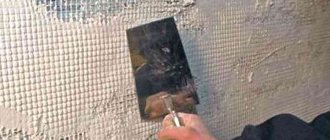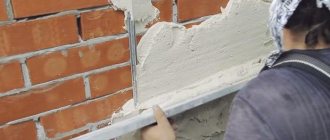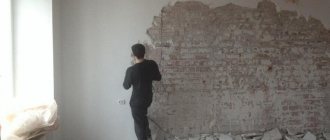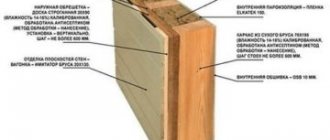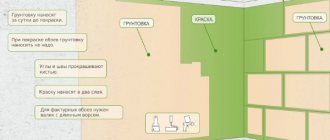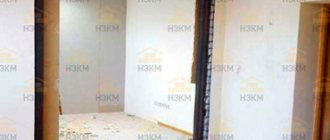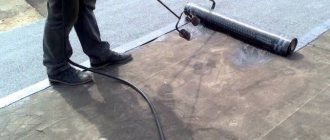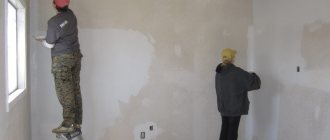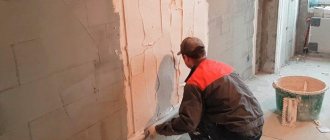Therefore, it is so important already in the first two stages to identify the causes of deformation in the masonry and evaluate the quality of the masonry - filling the seams with mortar, maintaining horizontality, thickness of the seams and their bandaging.
Dismantling of stone structures is carried out manually - if the damage is not large, using hand-held machines, mechanized or explosive methods. Manual dismantling requires a lot of manual labor, so dismantling of brick and rubble concrete structures is carried out manually only for small volumes of work and in cases where other methods cannot be used.
When manually dismantling brickwork laid on low-grade mortars, crowbars and picks are used. Dismantling is carried out in horizontal rows, starting from the top of the wall. When dismantling masonry made with strong mortars, a scarpel, wedges, sledgehammer, etc. are used. Repair of walls with rubble or rubble concrete masonry is carried out with a pick, crowbar and jackhammer.
Weathering of seams to a significant depth worsens the thermal properties of brickwork by 10-15%, and also reduces its load-bearing capacity by up to 15%. This defect is eliminated by strengthening the seams with cement mortar.
Lintels with single cracks are restored by injecting liquid cement or polymer cement mortar into them. When repairing arched lintels, the load from the floors is first removed from them, and then they are completely repositioned. When repairing wedge and row lintels, they are strengthened by installing steel or reinforced concrete beams.
Increasing load-bearing capacity and repairing brick walls
The processes of restoring and increasing the load-bearing capacity of brick walls, as well as repairing walls using traditional methods (reinforced concrete jackets, clips, etc.) are associated with a number of problems caused by the need for underlying structures and foundations to absorb additional loads from the mass of reinforcing reinforced concrete elements introduced into the structure layers. Thus, when installing a double-sided reinforced concrete jacket with a layer thickness of 5 cm, additional mass per 1 sq. m of reinforced wall is 250 kg.
The disadvantages of these methods also include their high material consumption, busy work, reduced cleanliness of the internal dimensions of the room, etc.
Therefore, today the most optimal method of repairing walls, the essence of which is a method of increasing the load-bearing capacity of brick walls with a low grade of masonry mortar by peripherally replacing the existing mortar in the horizontal joints of the masonry with a polymer-cement mortar, which is superior in adhesive and cohesive properties to similar indicators of brickwork.
The undoubted advantage of this method, along with significant savings in materials and labor costs, is the possibility of carrying out repair and restoration measures without increasing the mass of the wall and without reducing the internal dimensions of the premises.
Strengthening masonry under beam supports
If cracks appear under the supports of beams and floor purlins, local replacement of masonry sections is carried out, or a distribution reinforced concrete lining slab is installed; Before its installation, temporary fastenings are first placed under the floor beams, which are placed strictly vertically on all floors.
Openings and large holes are sealed with bricks or stones of the correct shape, as well as masonry walls of the appropriate thickness, tying with the old masonry and unstitching the seams.
Particular attention is paid to ensuring that the top of the opening or hole is carefully sealed. When laying the last top row of masonry, the seam between the old and new masonry is caulked with hard cement mortar. In this case, the last row is laid and stamped first, and then the front ones.
When sealing a small hole, nest or furrow, first clean the surface of the masonry from debris and wash it with water. Then individual bricks are selected and pinned together. After this, the mortar is thrown into the nest and the prepared bricks are laid. In this case, it is not necessary to bandage the old masonry with the new one. The furrows are sealed to the full depth or in the form of a partition enclosing a channel built in the wall.
Sealing beams.
The ends of beams are sealed both during the construction of new buildings and when repairing walls. When erecting stone buildings, floor beams are laid along the course of laying the walls: the masonry is brought to the level of the bottom of the beams or support pads, the places for the support pads are marked and they are laid. The top of the pillows is checked using a level or level. After this, the masonry is increased, erected two rows above the level of the interfloor ceiling, leaving nests for the beams. Nests with a height of more than four rows are laid with an inclined groove for better dressing when sealing. The ends of the beams placed in the nests are secured in the walls with steel T-shaped anchors.
Sealing cracks.
Before sealing cracks, it is necessary to eliminate the causes that cause them, and then make sure that the deformation of the walls has ended and the cracks do not increase. To do this, beacons made of gypsum mortar 50–100 mm wide and 6–10 mm thick are placed across the crack in several places. If the walls are plastered, then in the places where the beacons are installed, the plaster is knocked down, the masonry seams are cleared, the masonry and its seams are cleaned of dust and washed with water. Beacons cannot be placed on uncleaned and unwashed masonry, as they will not adhere to it and the increase in cracks in the masonry will not affect the gypsum beacon. The date of their installation is written on the lighthouses. If, for example, two to three weeks after installation, no cracks appear on the beacons, this means that the deformation of the wall has stopped. The period for monitoring deformations using beacons is determined depending on the suspected causes of deformations. Thin cracks are cleaned of dirt and dust and filled with liquid cement mortar, pumping it inside with a mortar pump. Wide cracks are repaired by dismantling parts of the old masonry and replacing it with new one.
When sealing cracks in walls 1.5 bricks thick, the masonry is dismantled and sealed sequentially in separate sections over the entire thickness of the wall in the form of brick locks. If the thickness of the cracks is significant, then anchors or beams are often installed to fasten the masonry. These beams are embedded in the masonry in the same way as lintels are installed over the punched openings.
Punching holes, slots, grooves.
Before punching holes, mark their position and, if necessary, install a scaffold of such a height that the punching site is at the level of the worker’s chest: in this position it is more convenient and easier to work.
Holes for electrical cables and pipes with a diameter of up to 40 mm are drilled with an electric drilling machine or punched with a jumper. Rectangular holes are punched with a scarpel, a jackhammer or an electric hammer, starting from the top of the hole.
For thick walls, it is advisable to punch holes first on one side half the thickness of the wall, and then on the other.
Before punching large holes and openings, first furrows 1/3 of a brick deep are made on both sides of the wall above the marked opening. Reinforced concrete lintels or steel beams 1 made of channel are placed in the furrows; the length of the laid sections is 500 mm greater than the width of the opening. The beams are tightened together with bolts 2 at the ends and in the span after 1-1.5 m. The gaps between the top of the beams and the masonry are caulked with hard cement mortar and after it has hardened, they begin to punch through the opening from top to bottom. First, furrows are laid on both sides below the jumper. Then, deepening and widening them, they make a through gap in the wall the width of the opening, and then break the masonry in rows, using ordinary hand or mechanized tools.
Repair of walls.
When repairing partitions, adjacent openings are filled with brickwork on clay mortar or temporary racks are installed in them to take the load from the overlying masonry. Then they sequentially dismantle and replace the destroyed masonry with a new one, and after it acquires the necessary strength, the temporary masonry is dismantled or temporary fastenings are removed.
How to strengthen a brick wall
Brick walls have always been considered the strongest and most reliable. However, over time they are also subject to destruction. Accordingly, their load-bearing capacity decreases. If you do not take urgent measures and strengthen the walls, sooner or later defects such as distortions, bulging, cracks, etc. will appear on them.
The reason for such sad consequences lies in the use of low-quality materials (including bricks or cement mortar). Natural aging accelerates the deterioration process. Also often the cause of wall destruction are:
- mistakes when designing a house;
- incorrect calculation of the foundation;
- construction of neighboring facilities;
- undersupply of building materials (for example, binders);
- human factor (poor quality of masonry);
- force majeure circumstances.
Strengthening brick walls is carried out using different technologies. They are conventionally divided into innovative and traditional.
Ways to decorate a house
Aerated concrete requires mandatory finishing, as over time it can begin to absorb moisture. Additional cladding helps retain heat and give the building an attractive appearance.
You can clad a building using facing bricks, which can be attached to the wall in different ways: this material not only has an attractive appearance, but will also reliably protect the aerated concrete from damage, cold and moisture.
Insulation can be placed between the cladding and the wall. Another advantage of brick is its ability to breathe: this will remove moisture from aerated concrete and give the facade the necessary ventilation. However, if the mortgages were not made initially, a problem may arise, since there is no fastening of the facing brick to the load-bearing wall. This can be solved; there are several ways to accomplish the task.
The canonical method of strengthening brick walls
Classic options for repairing collapsing brick walls include the following technologies:
- replacement (full or partial) of brickwork;
- use of steel clips;
- installation of encircling belts;
- installation of unloading beams, etc.
All traditional technologies are based on violating the aesthetics of the façade of the building. Therefore, when it comes to the restoration of the external masonry of buildings of historical value, such methods are not used.
If the building is not an object of historical heritage, or, moreover, the project provides for its external decoration, then traditional technologies can and should be used. However, you should know that modern, innovative technologies for restoring brickwork are still less expensive, faster and completely restore the strength and integrity of the masonry.
Dismantling a brick structure
This is an energy-intensive engineering and technical process of demolishing emergency or worn-out structures. Wall dismantling can also be performed in cases of repair or reconstruction of a building.
However, if all requirements are met, such dismantling can be carried out on your own, thereby significantly saving personal funds for repairing a house or apartment.
Before you begin dismantling, you need to know what type of wall it is: load-bearing or partition wall. This information for multi-storey buildings can be obtained from the operating organization, and for private owners - from the BTI.
The first type of walls serves as supports for the floor covering. It is prohibited to demolish them yourself, only in cases of complete dismantling of the object, after preliminary removal of the ceilings. Otherwise, the building may collapse and people may get trapped under the rubble. Walls of the second type - partitions - can be disassembled on your own, since this cannot threaten the collapse of the house.
Innovative ways to strengthen walls
The most effective method of strengthening walls is injection. Among other advantages, one cannot fail to note the versatility of this technology. Thus, using this method, repairs of foundations, walls, ceilings, etc., built from absolutely any building materials are successfully carried out.
Using injection, cracks in brick and concrete can be sealed equally reliably.
The essence of this method is that holes are drilled in the body of a collapsing building structure. Special repair compounds are pumped into them under pressure. These can be either microcements with additives or solutions based on polyurethane or epoxy resins.
As a result, the injection composition fills the voids formed in the structure. As a result, the restored wall stops collapsing and acquires reliable waterproofing. This method is used when it is necessary to quickly and reliably:
- perform general strengthening of the brick wall;
- seal and structurally bond wall cracks;
- protect walls from exposure to capillary moisture.
Brief conclusion
Strengthening the brick structure is carried out in order to prevent deformation of the walls, as well as to eliminate existing defects. It is important to start work on time to increase rigidity, so that subsequently part of the building does not sag or fall. The appearance of cracks is the first sign of loss of strength. The same defect can be eliminated in several ways. The method of strengthening depends on the technical characteristics of the masonry and the extent of its destruction. Reinforced concrete cages significantly increase the load-bearing capacity. Reinforcement of the opening can be done with steel strands. The extension is easily strengthened using reinforcement.
Reinforcement with composite materials
With the emergence of innovative materials, similar construction technologies emerged. They also did not avoid strengthening the brick walls. So, today canvases, tapes or meshes made of high-strength materials based on fiberglass or carbon are attached to collapsing structures. Epoxy or cement adhesive materials are used as glue.
Composite sheets are hundreds of times lighter and tens of times stronger than steel.
Frankly, the strengthening of brick walls with composite materials is just beginning in Russia. Although in the West this technology is used quite often. In our country, concrete structures are strengthened in this way, but more and more companies are actively starting to use composite sheets for the restoration of brickwork.
The essence of this method is that it is necessary not only to glue the damaged area with a composite material, but to loop it. This means that when reinforcing a main wall without openings, you will have to drill holes into which the carbon fiber will stretch. Next, the ends of the composite material are connected on the inside of the wall. Agree, implementing this technique is not so easy. At least without a special powerful construction wall chaser it is extremely difficult to do this.
Another disadvantage of using carbon or glass fibers is their high cost. And the labor intensity of this method is quite high. However, for those who are going to restore a crumbling brick wall once and for a century, something else is important:
The use of carbon fibers in strengthening brickwork increases the maximum permissible compressive load of the wall by 2-2.5 times compared to that required by SNiP.
There is one more point that, as a rule, is usually ignored by the residents of our region, but from which no one is ever immune. We are talking about a seismic threat. So, in this matter, composite materials will give odds to all other methods of strengthening walls.
All of the technologies for repairing brick walls discussed above have been successfully used for a long time. We have completed many similar works for both private clients and large organizations. And if you notice that everything is not in order with your brick wall, do not put off repairing it until later. Call us and we will strengthen your brick wall quickly, reliably and at an affordable price!
Fortification options
Reinforcement of brickwork can be internal and external, using metal fixtures. Inside, it is carried out using a mesh and metal rods, outside - using an anchoring or mesh structure that connects the seams of damaged parts of the wall.
When choosing the most suitable type of reinforcement, the following are always taken into account:
- expected loads that the brick wall will withstand;
- sequence of masonry work and type of dressing;
- formation of gaps between reinforced products, according to the project.
The location (option) of fortifications comes in several varieties:
- Longitudinal. It is considered the most common method. Suitable for external and internal work, used in work to strengthen lateral loads and bends. Uses any type of reinforced material. May intersect with vertical reinforcement elements.
- Transverse. This type of masonry reinforcement is suitable not only for external walls, but also for partition walls, as well as for the formation of columns.
Fasteners are laid inside the wall, every 3-4 layers of brick. Craftsmen often use self-knitted mesh (punched or stretched). This method secures the masonry well in bends and compression. Rods are rarely used here, and the mesh is often applied in a zigzag pattern, at a slight angle created by the products, in relation to the surface. - Vertical. With this type, rods of different lengths and diameters (usually up to 15 mm) are used, which are installed vertically at the base of the brickwork. The method of reinforcement here is internal and external, according to the engineer’s design. Here it is permissible to use wire with a diameter of 10 mm. It can be fixed to the wall surface using metal rods, anchors, corners and fastening material.
Whatever method the builder chooses, any of them will securely fasten the structure, make it durable, and will prevent the appearance of cracks.
Reinforced fasteners must be in good condition, without signs of corrosion. It is advisable that they be performed by a trusted manufacturer who can provide guarantees for their products.
Causes of cracks in the walls of a brick house
There are several reasons why a crack appeared in the wall of a brick house:
- Deformation and subsidence of the foundation due to erosion by groundwater, unevenly distributed load on the foundation or due to natural factors. When the foundation freezes and subsequent temperature changes occur, the binding composition of the foundation is destroyed.
- Over the course of two years, natural shrinkage of the house occurs. Depending on the composition of the soil on which the house is built, natural soil shifts may occur.
- During the pouring and arrangement of the foundation, the pouring technology was not consistent, low-quality materials were used, or the monolithic mass dried unevenly.
Methods
If you take the necessary measures in time, you can stop the process of destruction of the brick wall and completely restore the functionality of the masonry.
The main reasons why brick walls begin to deform:
- design errors made during the construction of the building: insufficient foundation depth, incorrect calculation of floors, when the bearing capacity of the walls does not correspond to the load placed on them;
- improper operation of the building;
- the use of low-quality materials and incorrect proportions of the solution;
- mistakes made at the design stage.
- improper insulation of a brick wall
Modern construction technologies make it possible to strengthen brick walls by placing them in the following frames:
- reinforced;
- compositional;
- metal;
- reinforced concrete.
To remove the force that destroys the wall, all factors must be taken into account: the brand of concrete and mortar, the condition of the masonry, the load placed on the wall, the percentage of its reinforcement.
The more reinforced clamps there are, the higher the strength of the brick wall will become. If there are cracks in the brickwork, then after strengthening it with the help of clips, the load-bearing capacity of the wall is completely restored.
To assess the extent of the damage, it is necessary to thoroughly clean the cracks from dirt and solution residues, and then rinse with water. If this is not done, but immediately sealed, then after a while the masonry will begin to collapse again.
To achieve maximum results, it is necessary not only to strengthen the brickwork using clips, but also to inject cracks with solutions that have sufficient viscosity and frost resistance, as well as insignificant water separation and shrinkage, high compressive strength and adhesion to the wall surface.
Elimination of the causes of cracks in brick walls
Before you start repairing cracks in a brick wall of a house, you need to determine the cause of its appearance. Most often it lies in the deformation of the foundation.
- Along the damaged section of the wall of a brick house, a trench is dug in width not exceeding the thickness of the foundation monolith and with a depth slightly below the lowest point of the foundation horizon.
- The damaged area is unstitched, i.e. cleared of loose stones and cement and the crack widens slightly.
- The cleaned and embroidered area is drilled vertically and horizontally under the reinforcing rod. The anchors are intertwined with reinforcing rods and fixed by welding. The distance between the rods is from 60 cm to 1 meter, depending on the width of the crack. They also serve as a connecting skeleton with a new strengthening foundation.
- The next step is to install the formwork and pour a reinforcing new foundation. Leave the trench filled with cement mortar until it dries completely and evenly. Moisten periodically with water to ensure uniform hardening of the solution.
- After reaching half the design hardness, after about 28 days, the area can be compacted and a blind area can be made.
Price of work per 1 linear meter in the Russian Federation
Depending on the type of walls and the number of channels used, prices in the Russian Federation vary from 4,000 thousand rubles to 11,000 thousand rubles.
| Double-row reinforcement of brick walls | Number of channels | Cost of 1 p.m. (rub.) |
| 12 | 4000 | |
| 14 | 4500 | |
| 16 | 5500 | |
| 18 | 5800 |
Prices include transportation costs within the city without parking costs. Outside the city, transport costs also increase.
Repairing cracks in a brick wall of a house
A strengthened foundation prevents further expansion and increase in length of cracks. To determine the moment of attenuation of the process, paper beacons are glued to the damaged wall and their integrity is monitored. When the cut along the wall of a brick house stops expanding, you can begin repairing the walls.
- Small cracks and shallow cracks, up to 5 mm wide, are covered with cement mortar. The edges of the cracks are beaten with a hammer, cleared of debris and moistened with water for high-quality adhesion to the solution.
- Medium cracks, these include cracks up to 10 mm, are sealed with a mixture of cement and sand in a ratio of one to three.
Method of strengthening brick surfaces
Currently, reinforcement of brickwork is carried out using the following clips:
Scheme of strengthening brickwork: 1 – crack, 2 – injection holes, 3 – injection pipes, 4 – cement-sand mortar, 5 – crack filled with cement mortar.
- reinforced,
- reinforced concrete,
- compositional,
- steel.
To correctly determine the strengthening technique, you need to take into account the following factors: the condition of the wall, the reinforcing coefficient, the grade of concrete or plaster composition, and the characteristics of the load on the surface. The strength of such a structure is determined by the percentage of reinforcement with clamps. During an external inspection of the building, you can check the number of cracks, their depth and width. The use of clips in reconstruction will allow you to recreate the load-bearing capacity of the building.
When assessing the external characteristics of load-bearing components, it is important to present this picture in reality. First, the walls are cleaned of dirt, debris and washed with water. Plaster subject to deformation is completely removed. It is worth noting that insufficiently good quality of surface cleaning will lead to rapid failure of the masonry.
Along with carrying out strengthening measures with clips, it is necessary to cover the cracks with a cement composition under pressure. Such measures will enhance the load-bearing capacity of the structure. The compositions used must have high frost resistance, be sufficiently viscous, have low shrinkage rates, adhere tightly to the brick and be compressed.
Repairing large cracks in the wall of a brick house
Gaps and cracks that exceed the average width are classified as critical and require emergency measures to eliminate them.
- An area of heavily damaged masonry is being dismantled. Disassembly is carried out from the upper rows. All damaged and loose bricks are removed.
- New bricks are laid in the vacated space using a brick lock. During installation, it is recommended to include scraps of metal reinforcement, corners or strips.
- To repair joints of brick walls, when the masonry is broken, strip steel linings are used. The ends of the steel strip are bent towards the brickwork and pressed out with bolts. In other cases, anchors or screws can be used.
- In some situations, when it is impossible to remove a damaged section of a brick wall, the cracks are filled with crushed stone and cement mortar. At a distance of 20 - 30 cm on both sides of the crack, “T”-shaped anchors are driven in and tied with a metal strip.
- If the cracks are deep and it is impossible to completely cement them, cemented injections are made. To do this, holes larger than 1 inch in size are drilled in increments of 20–25 cm along the entire length of the crack. A pipe filled with cement mortar is inserted into the drill holes and, using a rubber seal, the cement mortar is pumped into the gap in the brick wall.
- The solution can be supplied through the injectors using a mortar pump or a vacuum construction syringe, reliably filling all voids.
- It is allowed to use polyurethane foam to eliminate any type of cracks. After the polyurethane foam has hardened, it is cut to a depth of 2 cm and filled with cement mortar.
Applications of reinforced cage
In order to strengthen the walls and prevent new damage from occurring, you can reinforce the walls. This can be done using reinforcement cages, metal rods or reinforcing mesh.
The simplest option is to carry out reinforcement using reinforcing mesh, in this case, the order of work will be as follows:
- You can fix the reinforcing mesh on the wall either on one side or on both sides;
- before this it is necessary to drill holes;
- To fasten the mesh, through studs are used or this can be done using anchor bolts;
- after attaching the mesh, concrete mortar is applied to it, the grade of which should not be lower than M 100;
- the thickness of the solution layer is usually in the range of 20-40 mm;
- auxiliary metal rods with a diameter of 6 mm are attached along the height of the corners, 25-30 cm retreat from the edge;
- if the mesh is installed on only one side, then studs or anchors with a diameter of 8 mm are used in increments of 60-75 cm;
- if the reinforcing mesh is attached to both sides of the wall, then the diameter of the studs is at least 12 mm and their pitch is 100-120 cm;
- The reinforcing mesh is attached to the anchors or studs using welding or knitting wire.
Strengthening brick walls from the inside
In cases where cracks and breaks in the masonry are especially catastrophic and the wall of a brick house is cracked through and through, then after repairing and strengthening the outside, the walls are strengthened from the inside.
- Clean the damaged area from plaster and dirt. Moisten the gap as deeply as possible.
- Fill the gap with cement mortar and small crushed stone.
- If necessary, install metal plates from rolled strip. Anchors or dowels are used to secure the strips.
- After drying, you can begin finishing work on the inside of the damaged part of the brick wall of the house.
Do-it-yourself reinforcement of structural elements with steel ties
The cracks are cleaned of dust, mortar and damaged parts, washed with a brush and water, then primed and filled with fresh solution (cement, sealant or polyurethane foam along the entire depth of the destruction). But before that, perform a standard screed as follows:
Metal corners 100 x 100 (mm) are mounted in the corners, grooves are cut into the existing plaster for further masking with mortar.- From the corners with grooves, thick steel strips with holes are installed, which are connected at the ends with rods and tightened with nuts.
- Weld sections of pre-prepared pipes to the corners (minimum length of metal parts along the length is 150 mm), which are located in two directions.
- The existing cuttings of twenty-centimeter studs in the wall are connected by welding to the remaining reinforced parts, and then fixed with nuts, which can be slightly heated with an autogen for better tightening.
- The welding site is additionally reinforced with metal pieces 120 mm long.
- After screeding, the cracks begin to be sealed.
After the screed and mortar have dried, painting work (plastering and finishing) is carried out.
For monolithic and steel frames of standard thickness (40 mm), after their installation, 2 main methods are used: shotcrete and pneumatic concrete surface, which precedes plastering work.
When the thickness of the clips is greater than standard (for example, up to 120 mm), inventory formwork is used , installed at the height of the surface being repaired, into which the tubes are inserted, to supply a fine-grained concrete mixture.
The reinforcement frame is made from longitudinal rods of class A, described in GOST (I-III). Steel and composite frames are always secured with corners around the perimeter.
The reinforced cage is made using metal rods (diameter up to 6 mm). To do this, step back from the edge of the corners by 25 or 30 cm. When using a mesh, take studs and anchors. They can be attached on both sides, depending on the damaged surface. The reinforcing mesh can be reinforced by welding or tied with wire yourself.
The thickness of the poured cement layer on top of the screed, according to regulatory rules, must be more than 3 cm. This is necessary in order to protect the reinforced parts from corrosion.
When you need to strengthen
If a new house is being built, then when drawing up the project, the most suitable method of strengthening door and window openings and arches is taken into account. But there are situations when it is necessary to strengthen the opening in an existing building.
Cases when it is necessary to strengthen openings:
- If the walls of the building have become deformed, cracked due to time or mechanical damage. The technical condition of the house needs to be monitored. If cracks appear, the cement bonding layer is destroyed, or bricks fall out, restoration work must be urgently carried out. Timely measures taken will help keep the premises in good condition longer.
- When redevelopment is carried out, the holes are widened or they are made in other places. In these cases, reinforcements are installed even before new openings are dismantled. First, you need to draw up a project for carrying out the work, after consulting with a specialist, whether it is possible to break through the wall in the chosen place, and whether this will weaken the structure of the building.
- When replacing windows, you need to check before carrying out the work how strong the opening is, and, if necessary, pre-strengthen it before dismantling the old window.
Strengthening columns
Columns are vertical building structures of buildings and structures that are used to create a frame structural scheme. Columns are usually installed on their own separate foundations in a rigid or hinged assembly. Columns are calculated as stand-alone racks or as part of a frame in the longitudinal and transverse directions. The main forces acting in the columns are compressive forces, as well as bending moments from wind influences and vertical forces applied with eccentricity.
As part of buildings, columns can be: steel; brick; prefabricated reinforced concrete; monolithic reinforced concrete. When conducting a technical condition inspection, defects, damage and deformations of columns within a building or structure may be identified, such as: Deviations from the vertical; Bending, bent steel columns; Bends of working reinforcing bars due to overload; Corrosion of reinforcement due to the absence, violation or carbonization of protective concrete;
The listed factors can be left unchanged or restored through repair. One way or another, this decision can only be made based on the results of a calculated assessment of the bearing capacity of the column, taking into account identified defects and damage, as well as taking into account the actual geometric and strength parameters. When identifying insufficient strength of the cross-section of columns to accommodate the design combination of operational loads or determining excess flexibility, a decision is made to strengthen the building structures.
Methods for strengthening columns.
What is column strengthening, tasks and goals. Strengthening implies the restoration of strength, rigidity and flexibility of building structures, the parameters of which were lost during operation or acquired at the stage of manufacture and installation. The choice of the type and method of strengthening columns depends on their type, operating conditions, as well as the level of overload (degree of insufficient load-bearing capacity) of the structure.
Strengthening steel columns: By increasing the cross-section by welding elements (rods, sheets or rolled sections). View the embedded image gallery online at: https://expert-proect.ru/usilenie-stroitelnykh-konstruktsij/usilenie-kolonn#sigFreeIdfba37cf57d Using the method of reducing the estimated length by introducing spacer elements both in the plane and from the plane. View the embedded image gallery online at: https://expert-proect.ru/usilenie-stroitelnykh-konstruktsij/usilenie-kolonn#sigFreeIde908b3d385 Strengthening reinforced concrete columns: Using the method of compression with a steel cage by installing rolled steel angles at the corners of the column to its entire design height , tightening them with horizontal strips and installing supporting elements to ensure the perception and further transmission of vertical forces. The method of constructing a reinforced concrete jacket by installing a reinforcement cage on each side, attaching it to the body of the column and further concrete coating each side to ensure adhesion of the existing and new concrete. The method of increasing longitudinal working reinforcement by welding additional rods to existing ones, located in the corners of the cross section with further concrete coating of the structure. Strengthening brick columns. It is carried out, as a rule, by crimping with a steel clip; this method is described in detail in the section “strengthening walls”. View the embedded image gallery online at: https://expert-proect.ru/usilenie-stroitelnykh-konstruktsij/usilenie-kolonn#sigFreeIdbcba28c72c
One way or another, the choice of the type and method of strengthening columns is carried out individually for each specific case. There are significantly more methods for strengthening columns than are presented above on our website. The need for reinforcement is determined only based on the results of a technical inspection of building structures. Contact us, our reconstruction and strengthening department specialists will always be able to advise you on any issue of interest.
Methods for strengthening openings in a monolithic or brick house
The strengthening technology is selected depending on the thickness of the wall, what material it is made of, and the size of the hole itself. Several options are used to strengthen brick walls:
- Reinforced concrete lintel. It is mainly used only during the construction of a facility, with the use of special equipment. Because due to its heavy weight and large size, its installation during repair work is difficult.
- Steel channel. This method is the most common. It does not require large expenditures; two workers are enough to install it. The steel channel structure is secured with threaded ties. If the opening width is more than 1 m, then it is additionally reinforced with a metal clip.
- Metal frame (clip). Necessary for deformed, destroyed openings of brick walls. It is a durable structure connected from steel corners. Special supports are attached to its lower part.
- Metal corners. Installed on all sides of a door or window opening or just as lintels. At the edges of the opening they are fixed with anchors. They are attached to each other by metal plates by welding. Metal “heels” are welded under the supporting elements to evenly distribute the load.
Unlike brick walls, it is much more difficult to make openings in monolithic ones, because there is reinforcement inside the concrete. Here it is necessary to use diamond cutting to cut the metal and also to create a hole without the risk of cracks in the wall.
Since almost all monolithic walls are load-bearing, it is necessary to involve specialists to calculate the location for a new hole in which the strength of the structure will not be compromised. The opening is strengthened with a U-shaped welded metal structure.
Door
The design of a door frame is similar to a window frame. The difference is that the horizontal bar below is the threshold. Doors can be external (the openings are located in load-bearing walls) or internal (then a particularly reinforced frame is not necessarily required).
- To strengthen the holes in the load-bearing walls, high-strength channels are selected, corresponding in size to the thickness of the brick wall. A U-shaped frame is made from them. Then this structure is mounted in the opening and secured with anchors.
- Internal openings are reinforced with corners. They fit more tightly, which makes finishing work easier in the future, and the openings look neater. First, vertical posts are made that carry the main load, which are then connected with corners. Afterwards, the corners are installed in the upper opening and the entire structure is tightened with studs.
Window
Windows are located in external walls, which are load-bearing and are subject to heavy loads. Therefore, reinforced structures are used for such openings.
Most often used for windows of brick buildings:
- Channel profile. At the place where it is attached to the opening, a groove is made, into which the channel is then tightly inserted and secured with cement-sand mortar. To connect the profiles, special studs and washers with nuts are used.
- Vertical supports made of two channels. Installed with wide window openings (more than 1.5 m). Such racks are welded to channels secured along horizontal jumpers.
Creation of a reinforced concrete belt
This method of strengthening walls is inexpensive and requires minimal time for installation. The thickness of the reinforced concrete frame ranges from 4 to 12 cm; it is created using fine-grained concrete and reinforcement laid in the longitudinal and transverse directions.
The reinforced concrete frame is attached to the wall using clamps; it is installed along the perimeter of the building and thus creates a reinforcement mesh.
To strengthen the wall , the created reinforced concrete shell must exceed its strength several times. After installation, the reinforced concrete shell takes on part of the load created on the wall, thus unloading it and stopping its damage.
If it is necessary to make a casing up to 40 mm thick, it is done using the method of pneumatic concrete and shotcrete, after which the surface is covered with plaster.
If the layer of the frame is up to 120 mm thick , then it is made using inventory formwork; it is installed around the wall being repaired to its entire height.
After creating the formwork, special tubes are inserted into it, through which concrete mixture having a fine-grained structure is supplied.
Recommendations and tips
The work performed to create and strengthen openings in walls made of brick or other materials is very responsible. Therefore, first of all, you need to make the correct calculations, select the appropriate materials and tools, and take into account all the features of the wall.
What you need to know about the wall before carrying out work:
- is it load-bearing or is it an ordinary partition;
- its thickness;
- whether pipes or fittings are installed in it;
- where the electrical wiring goes.
What materials to choose to reinforce openings:
- channels are suitable for brands 10P, 12P, 14P;
- the thickness of the corners must be at least 5 mm, and the dimensions of their shelves must be at least 60×60 mm;
- stud brands from M16 to M23 and the distance between them is no more than 30 cm.
To carry out the work efficiently, you will need the following tools:
- perforator;
- wall chaser;
- welding machine;
- spanners;
- devices for markings.
Strengthening openings requires a responsible approach from drawing up a work project to its implementation. You shouldn’t rely only on your own strengths, especially if you don’t have enough experience. You definitely need to use the services of specialists - architects, engineers, skilled workers.
You should not save on materials and labor costs. Timely completion of work to restore the strength of a window or doorway will allow you to avoid unnecessary problems and expenses later, and ensure safety and comfortable living.
What it is?
To prevent construction errors in the form of cracks on the walls and their destruction, during masonry work they must use reinforcement - pouring a solution of mounting mesh or rods of various diameters, as well as additional strengthening of the walls using installation devices.
Reinforcement is especially helpful on structural (load-bearing) walls - it is used as a preventative against construction errors , as well as in case of identified violations of masonry technology and destruction caused by certain factors:
fundamental reasons (incorrect design, lack of technology for working with soils, earthworks with disrupted development technology);- natural disasters (seismic rapids, hurricanes, floods);
- mechanical damage (external influences – various accidents);
- atmospheric changes due to climatic conditions (hot and cold, condensation formation).
Additional strengthening of walls helps to avoid cracking on the surface and costs associated with repair and restoration of the surface.
Most often, additional reinforcement is required when the process technology is broken, for example, when construction is rushed and the foundation is not given enough time to shrink during the year. Reinforcement is also necessary for buildings located on heaving soils, even if they have a monolithic foundation.
Reinforcement can remove a large load from the walls , distributing it evenly along the entire perimeter of the structure, help with complex masonry (for example, arches and pillars), eliminate errors (if low-quality materials were used), and also make the walls invulnerable in earthquake-prone regions.
To strengthen the walls, steel rods and wires, individual metal anchor frames, and various fasteners are used.
Metal rods have a diameter of 3 to 8 mm, and mesh reinforcement can be factory-made or independently tied (construction wire), with cells from 40 x 40 (mm) and higher. Reinforcement and mesh can be laid in different directions, every 3-5 rows. It interacts well not only with the brick surface, but also with mortars that are used for masonry work (most often sand-cement).
Modern manufacturers are currently producing brick products using new technologies, thanks to which the brick wall being built does not require reinforcement, despite the fact that building codes oblige it.
But most builders advise not to neglect the technology of strengthening walls. There is no need for it when the wall, half a brick thick, does not exceed 3 m, and is not subject to heavy loads, as well as when the wall is very thick and for small buildings.
Reinforcement and reinforcement are indicated for those houses that are being built on unstable soils, for proper shrinkage of the building, without a tendency to destruction, and also if chipped bricks are used in the work.
Strengthening the walls of buildings and houses
Building a house using brick is one of the most common options today.
No matter how expensive materials are purchased for the construction of a structure, after a certain period of time cracks may appear in the walls, which indicates the presence of a negative process occurring in the foundation. It is important to carry out repair work to eliminate the defect as quickly as possible. Otherwise, the building may warp, internal surfaces may deform, and the foundation may completely crumble.
If the wall of a brick house is cracked, then before starting repair work you should understand the reasons for the appearance of such a defect. Experts highlight the following points that led to destructive consequences:
- the close location of groundwater can lead to erosion of the foundation, resulting in base deformation and subsidence. In addition, constant changes in temperature negatively affect the binders that make up the foundation;
- shrinkage of a house is a natural process. Depending on the composition of the soil, soil displacement may take place over several years;
- When pouring the foundation, the technological process was disrupted or low-grade material was used.
Stages of deformation of brickwork
- Tension in the structure that does not entail damage to the masonry.
- The appearance of minor cracking in some bricks, so-called hairline cracking.
- Connection of several clefts with vertical seams. This contributes to the delamination of the masonry.
- Gradual deformation of the base of the wall.
Already at the first signs of such manifestations, it is important to understand the reasons and monitor the quality indicators of the laid brick. It is necessary to monitor the binding of the external walls, the height of the seams, maintaining a horizontal base and filling these gaps with the composition.
Strengthening a brick wall or eliminating it?
What is the process of strengthening a brick wall? In fact, eliminating cracks in brick walls is a rather labor-intensive process and requires special attention. In most cases, the defect appears due to deformation of the base. If a crack is obvious in the foundation of a brick house, then the following measures will need to be taken:
- along the wall where there is a crack, a trench of certain overall dimensions is dug near the foundation;
- the area with the crack is opened with extreme care and caution (the hole widens slightly);
- To understand how to strengthen the foundation of a brick house, you need to drill holes for the reinforcement rod in a cleared area. If necessary, welding can be used. Thus, a kind of connecting link is created;
- Next, the formwork is installed and a new layer of foundation is poured. Leave the trench filled with solution until completely dry;
- After at least 28 days, compaction can be carried out on the site and a blind area can be built.
Strengthening the foundation
Serious problems with structural integrity require a total rebuild of the foundation:
Strengthening the foundation of the house
- The first step is to make a deep trench along the wall with a crack to the level of the base horizon. The width of the trench should not be greater than the thickness of the foundation.
- After this, the crack needs to be widened a little, cleaned of weakly reinforced stones and the cement that adheres them.
- The expanded and cleaned area is drilled horizontally and vertically for reinforcement. It is necessary to intertwine reinforcing bars of suitable size with anchors and secure them by welding. The distance between the rods depends on how wide the crack needs to be repaired. This reinforcement is made as a further connection with the skeleton of the new reinforcing foundation.
- Now you can make formwork and pour concrete into it. To prevent new cracks, all work on the base is carried out only after it has dried. You can also spray it with water occasionally to help it cure evenly.
Repair work to strengthen the foundation of a brick wall
What is strengthening the foundation of a brick wall? By strengthening the foundation in the future, you can prevent the formation of new cracks, as well as stop the expansion of existing ones. Moreover, this concerns the growth of the defect both in length and width. If the wall of a brick house has burst, then in addition to strengthening the foundation, a simple procedure should be carried out, the results of which will make it obvious whether the growth of the split has stopped. It is enough to stick unique beacons made of paper onto the cracks in the walls of a brick house. If after a certain period of time the stickers remain intact, then you can safely begin repair work. To do this you need to do the following:
- minor cracks in the brickwork, the causes of which have been established, and the width does not exceed 5 mm, can be covered with ordinary cement mortar. First, the edges of the recess must be carefully beaten, construction debris must be removed, and the surface must be moistened with water for better adhesion to the cement mixture;
- if the width of the gap reaches 10 mm, then it is sealed with cement-sand mortar prepared in a ratio of 1:3.
- Initially it is necessary to dismantle the damaged section of the wall
- When a brick house is cracked and the width of the target exceeds the average size, then you should approach this task more thoroughly. By first eliminating the causes of cracks in the brickwork, you can take emergency measures to eliminate surface defects, restoring its integrity.
- Before strengthening brick walls, it is necessary to disassemble the damaged fragment of masonry. The disassembly procedure is carried out from the top row. All bricks that are damaged or do not hold tightly enough must be removed.
- Elimination of cracks in brickwork occurs by laying new bricks on the cleaned part of the wall. Many may ask the question of how to strengthen the walls of a brick house so that history does not repeat itself in the future. It is enough to include reinforcement, metal corners or strips in the process of making new masonry. In addition, the masonry must end with a lock.
- When restoring components of a brick house, you need to use strips of steel. Such linings are fastened with bolts or other elements to impart strength and reliability to the structure.
- If a brick wall is cracked and it is impossible to remove bricks, then the damaged area must be filled with a mixture of crushed stone and cement mortar. Having retreated 20-30 cm from the edge of the crack, a “T”-shaped anchor is fastened, after which the gap is connected with a strip of metal.
- How to strengthen a brick wall if the gap is deep enough? Very simple. Holes need to be drilled along the entire length of the crack, the spacing between which can vary within 20-25 cm. A pipe is inserted into the resulting holes, with the help of which the hole is filled with cement mortar. Pipe nozzles can be used that are most suitable for filling holes of various diameters.
- Strengthening cracks in brickwork can also be done using polyurethane foam. After the foam has completely hardened, the excess is cut off and the surface is treated with cement mortar.
Replacement and strengthening with a stiffening belt
- When a section of a brick wall has been severely deformed, it must be completely replaced.
Before you begin to dismantle the wall of the house, you should reliably strengthen that part of the wall that is located directly above the damaged area and cannot be subsequently replaced. Then you need to start dismantling the deformed section of the brick wall being strengthened. The area should be dismantled from the top.
Next, this section is re-laid with bricks, which have increased strength. The connection between new and old masonry should be caulked extremely securely using a semi-rigid mortar.
This solution is prepared in this way: pour cement into a container, fill it with water and mix
It is very important that every grain of cement gets wet
Next, add a little fine screenings, plasticizer and 2 parts of sand to the cement water. Mix everything well. For such purposes, scraps of reinforcement or metal pins can be used, laid in a checkerboard pattern in increments of 400-600 mm.
All temporary fastenings can be removed only after the masonry reaches its own strength of at least 50%.
Scheme of strengthening a wall with a stiffening belt
- Strengthening a brick wall with a stiffening belt. In order to maximally strengthen the brickwork of the walls of the house, you can make a monolithic stiffening belt from a material such as reinforced concrete.
Such a belt can be made completely monolithic, or from slag concrete. The monolith will take quite a lot of time, but slag concrete also has a significant drawback - slow hardening. But it can also be made from a channel.
The stiffening belt is designed to significantly reduce the sensitivity of the wall of a brick house to various precipitation. Such a belt instantly absorbs tensile forces and does not allow deformation of the surface of the wall of a brick house to develop.
The places where repair work will be carried out must be completely cleared of plaster, and grooves or grooves must be made. Next, you should install a frame made of metal material in them and tighten it with bolts. If the surface of the wall of the house is quite long, then in its center it is also necessary to arrange a screed using bolts.
A rigid belt can be made both around the entire perimeter of the building, and in individual places from the corner of the building. First, you need to make a stiffening belt on one side, and only after that on the opposite side.
What to do if there are vertical cracks
Both vertical and horizontal cracks in the brickwork that have passed through are eliminated if a complex of restoration works is carried out. After you have succeeded in strengthening the brick wall from the outside, you can begin repair work inside the building.
- The area of the wall where there are cracks is thoroughly cleaned of dirt and plaster. The crack is moistened as much as possible inside.
- Before strengthening the old brick wall inside, the existing cracks should be filled with a solution of fine crushed stone and cement.
- The window section in the brick wall is carefully inspected to identify damage. It may be necessary to remove this window opening and then install a more advanced one, for example, a plastic one.
- Before tightening the walls of a brick house, you need to carefully inspect the entire surface of the wall and fill all existing cracks. Only then are metal overlays mounted, which are fixed with any fastening element (bolts, anchors, dowels).
- The wall is plastered with special means. After the surface has completely dried, you can safely begin tiling work indoors. Read more about how to plaster a brick wall by following the link.
- It is extremely necessary to carry out such work. After all, through cracks in the foundation and wall, flows of cold air can penetrate into the room, which is simply not acceptable. After sealing the cracks, you can additionally place a layer of thermal insulation material to create a kind of barrier to the cold. This, in turn, will significantly save money on energy bills, which is very important at the present time. It is also worth paying attention to the option of plastering a brick wall with clay.
Restoration of brick partitions
To repair brickwork, especially to get rid of cracks, metal overlays are installed on the outside of the wall. They help strengthen the structure and prevent it from collapsing further. First, the gap should be sealed with paper, and after some time, its condition should be assessed. Its integrity indicates the completion of the deformation process in the building. This means it is time for repair work. The break in the strip indicates the continuation of such destruction.
Metal overlapping elements strengthen the structure and prevent it from further deteriorating.
Therefore, it is necessary to determine the cause of this phenomenon and take certain actions to eliminate them. It is important to pay attention to the quality of the foundation; it may require strengthening.
In some cases, strengthening of masonry supports using the method of reinforcement and high-quality ligation of the structure is used. Sometimes, in order to firmly fix the walls, special corsets are used, made from reinforced concrete compounds by increasing their cross-section.
Adviсe:
- Dismantling of brick walls with minor defects is carried out on their own. Typically, special hand-held machines, blasting techniques and mechanical cleaning methods are used here.
- The use of a manual method for dismantling partitions gives the right to use a pickaxe and a crowbar. The movements are carried out in this order: start at the top, gradually move down, maintaining the horizontality of the rows.
- To dismantle a particularly strong base of the wall, take a sledgehammer, scarpel, and wedges.
- You can dismantle a plane consisting of rubble or rubble concrete with a jackhammer, pick and crowbar.
Stages of strengthening concrete walls
Before starting any work, specialists carefully examine the walls of the building that require reinforcement. At the same time, the reasons for the decrease in the performance properties of concrete are identified in order to avoid ineffective repairs in the future. Based on the results of the survey, a decision is made in favor of certain methods of strengthening concrete walls, and the optimal materials for a particular case are selected.
If it is decided to strengthen and waterproof the monolith using injection, then the walls are pre-prepared - cleaned of interfering finishes, dilapidated and chipping concrete, cleaned and blown. The resulting cracks and seams are expanded and markings are made for the installation of injectors.
After the preparatory work, the concrete walls are directly strengthened by introducing composite restoring materials through injectors under pressure. Thanks to this or that composition used, the voids inside the concrete are quickly filled, bonded and its structure is strengthened. The monolith becomes effectively protected from moisture and further destruction under operational loads (vibrations, shocks, etc.).
